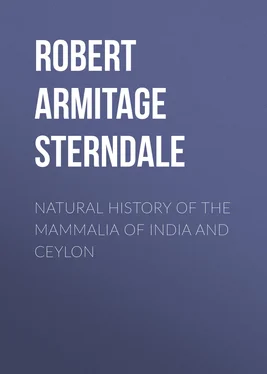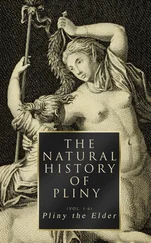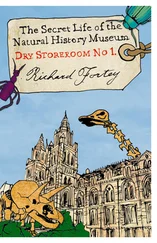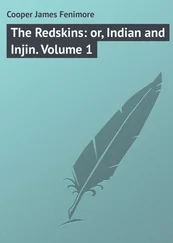Robert Armitage Sterndale - Natural History of the Mammalia of India and Ceylon
Здесь есть возможность читать онлайн «Robert Armitage Sterndale - Natural History of the Mammalia of India and Ceylon» — ознакомительный отрывок электронной книги совершенно бесплатно, а после прочтения отрывка купить полную версию. В некоторых случаях можно слушать аудио, скачать через торрент в формате fb2 и присутствует краткое содержание. Жанр: foreign_edu, Биология, на английском языке. Описание произведения, (предисловие) а так же отзывы посетителей доступны на портале библиотеки ЛибКат.
- Название:Natural History of the Mammalia of India and Ceylon
- Автор:
- Жанр:
- Год:неизвестен
- ISBN:нет данных
- Рейтинг книги:5 / 5. Голосов: 1
-
Избранное:Добавить в избранное
- Отзывы:
-
Ваша оценка:
- 100
- 1
- 2
- 3
- 4
- 5
Natural History of the Mammalia of India and Ceylon: краткое содержание, описание и аннотация
Предлагаем к чтению аннотацию, описание, краткое содержание или предисловие (зависит от того, что написал сам автор книги «Natural History of the Mammalia of India and Ceylon»). Если вы не нашли необходимую информацию о книге — напишите в комментариях, мы постараемся отыскать её.
Natural History of the Mammalia of India and Ceylon — читать онлайн ознакомительный отрывок
Ниже представлен текст книги, разбитый по страницам. Система сохранения места последней прочитанной страницы, позволяет с удобством читать онлайн бесплатно книгу «Natural History of the Mammalia of India and Ceylon», без необходимости каждый раз заново искать на чём Вы остановились. Поставьте закладку, и сможете в любой момент перейти на страницу, на которой закончили чтение.
Интервал:
Закладка:
Body and limbs slender; no tail; eyes very large, almost contiguous; nose acute.
NATIVE NAMES.— Tevangar , Tamil; Dewantsipilli , Telegu. ( Oona happslava , Singhalese.— Kellaart .)
HABITAT.—Southern India and Ceylon.
DESCRIPTION.—Above greyish rufescent (tawny snuff brown: Kellaart); beneath a paler shade; a white triangular spot on forehead, extending down the nose; fur short, dense, and soft; ears thin, rounded (Jerdon). A hooped claw on inner toes; nails of other toes flat; posterior third of palms and soles hairy (Kellaart).
SIZE.—About 8 inches; arm, 5; leg, 5½.
This, like the last, is also nocturnal in its habits, and from the extreme slowness of its movements is called in Ceylon "the Ceylon sloth." Its diet is varied—fruit, flower, and leaf buds, insects, eggs, and young birds. Sir Emerson Tennent says the Singhalese assert that it has been known to strangle pea-fowl at night and feast on the brain, but this I doubt. Smaller birds it might overcome. Jerdon states that in confinement it will eat boiled rice, plantains, honey or syrup and raw meat. McMaster, at page 6 of his 'Notes on Jerdon,' gives an interesting extract from an old account of 'Dr. John Fryer's Voyage to East India and Bombain,' in which he describes this little animal as "Men of the Woods, or more truly Satyrs;" asleep during the day; but at "Night they Sport and Eat." "They had Heads like an owl. Bodied like a monkey without Tails. Only the first finger of the Right Hand was armed with a claw like a bird, otherwise they had hands and feet which they walk upright on, not pronely, as other Beasts do."
These little creatures double themselves up when they sleep, bending the head down between their legs. Although so sluggish generally, Jerdon says they can move with considerable agility when they choose.
There is a curious link between the Lemurs and the Bats in the Colugos. ( Galæopithecus ): their limbs are connected with a membrane as in the Flying Squirrels, by which they can leap and float for a hundred yards on an inclined plane. They are mild, inoffensive animals, subsisting on fruits and leaves. Cuvier places them after the Bats, but they seem properly to link the Lemurs and the frugivorous Bats. As yet they have not been found in India proper, but are common in the Malayan Peninsula, and have been found in Burmah.
NATIVE NAME.— Myook-hloung-pyan , Burmese.
HABITAT.—Mergui; the Malayan Peninsula.

DESCRIPTION.—Fur olive brown, mottled with irregular whitish spots and blotches; the pile is short, but exquisitely soft; head and brain very small; tail long and prehensile. The membrane is continued from each side of the neck to the fore feet; thence to the hind feet, again to the tip of the tail. This animal is also nocturnal in its habits, and very sluggish in its motions by day, at which time it usually hangs from a branch suspended by its fore hands, its mottled back assimilating closely with the rugged bark of the tree; it is exclusively herbivorous, possessing a very voluminous stomach, and long convoluted intestines. Wallace says of it, that its brain is very small, and it possesses such tenacity of life that it is very difficult to kill; he adds that it is said to have only one at a birth, and one he shot had a very small blind naked little creature clinging closely to its breast, which was quite bare and much wrinkled. Raffles, however, gives two as the number produced at each birth. Dr. Cantor says that in confinement plantains constitute the favourite food, but deprived of liberty it soon dies. In its wild state it "lives entirely on young fruits and leaves; those of the cocoanut and Bombax pentandrum are its favourite food, and it commits great injury to the plantations of these."— Horsfield's 'Cat. Mam.' Regarding its powers of flight, Wallace, in his 'Travels in the Malay Archipelago,' says: "I saw one of these animals run up a tree in a rather open space, and then glide obliquely through the air to another tree on which it alighted near its base, and immediately began to ascend. I paced the distance from one tree to the other, and found it to be seventy yards, and the amount of descent not more than thirty-five or forty feet, or less than one in five. This, I think, proves that the animal must have some power of guiding itself through the air, otherwise in so long a distance it would have little chance of alighting exactly upon the trunk."
There is a carefully prepared skeleton of this animal in the Indian Museum in Calcutta.
ORDER CARNARIA
It may seem strange to many that such an insignificant, weird little creature as a bat should rank so high in the animal kingdom as to be but a few removes from man. It has, however, some striking anatomical affinities with the last Order, Quadrumana , sufficient to justify its being placed in the next link of the great chain of creation.

"Bats have the arms, fore-arms and fingers excessively elongated, so as to form with the membrane that occupies their intervals, real wings, the surface of which is equally or more extended than in those of birds. Hence they fly high and with great rapidity."— Cuvier . They suckle their young at the breast, but some of them have pubic warts resembling mammæ. The muscles of the chest are developed in proportion, and the sternum has a medial ridge something like that of a bird. They are all nocturnal, with small eyes (except in the case of the frugivorous bats), large ears, and in some cases membranous appendages to the nostrils, which may possibly be for the purpose of guiding themselves in the dark, for it is proved by experiment that bats are not dependent on eyesight for guidance, and one naturalist has remarked that, in a certain species of bat which has no facial membrane, this delicacy of perception was absent. I have noticed this in one species, Cynopterus marginatus , one of which flew into my room not long ago, and which repeatedly dashed itself against a glass door in its efforts to escape. I had all the other doors closed.
Bats are mostly insectivorous; a few are fruit-eaters, such as our common flying-fox. They produce from one to two at a birth, which are carried about by the mother and suckled at the breast, this peculiarity being one of the anatomical details alluded to as claiming for the bats so high a place.
Bats are divided into four sub-families—Pteropodidæ, Vampyridæ, Noctilionidæ, and Vespertilionidæ.
These are frugivorous bats of large size, differing, as remarked by Jerdon, so much in their dentition from the insectivorous species that they seem to lead through the flying Lemurs ( Colugos ) directly to the Quadrumana . The dentition is more adapted to their diet; they have cutting incisors to each jaw, and grinders with flat crowns, and their intestines are longer than those of the insectivorous bats. They produce but one at birth, and the young ones leave their parents as soon as they can provide for themselves. The tongue is covered with rough papillæ. They have no tail. These bats and some of the following genus, which are also frugivorous, are distinguished from the rest of the bats by a claw on the first or index finger, which is short.
Читать дальшеИнтервал:
Закладка:
Похожие книги на «Natural History of the Mammalia of India and Ceylon»
Представляем Вашему вниманию похожие книги на «Natural History of the Mammalia of India and Ceylon» списком для выбора. Мы отобрали схожую по названию и смыслу литературу в надежде предоставить читателям больше вариантов отыскать новые, интересные, ещё непрочитанные произведения.
Обсуждение, отзывы о книге «Natural History of the Mammalia of India and Ceylon» и просто собственные мнения читателей. Оставьте ваши комментарии, напишите, что Вы думаете о произведении, его смысле или главных героях. Укажите что конкретно понравилось, а что нет, и почему Вы так считаете.












